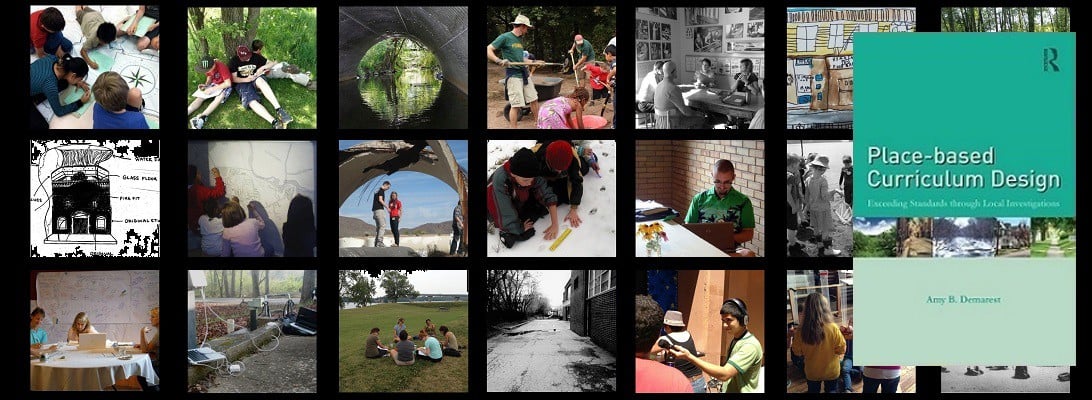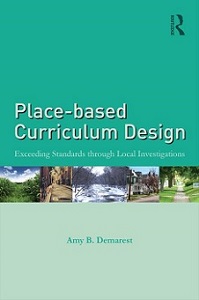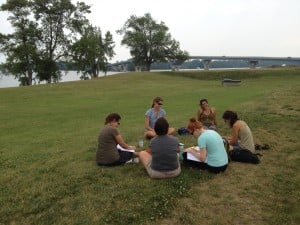My book Place-based Curriculum Design: Exceeding Standards Through Local Investigations is coming out among much good company! It is one of the books about place-based education that will debut this year amidst an increased unrest about the weight of standardized tests–and growing frustration of teachers who are weary of being told what to do in ways that make learning irrelevant for their students.
There are a number of new titles that I haven’t even seen yet! I have ordered — but not yet received — a copy of A Place to Learn: Place-Based Pedagogy and Critical Literacy by Amy Azano. It sounds like her focus is mostly on poor, rural communities (but most likely not exclusively) and she uses Friere’s view of literacy and critical engagement. From a peek at the Table of Contents she has an interesting framework of BELONG, LIVE, UNDERSTAND, and ENGAGE to consider learning activities. Can’t wait to read it!
Routledge is publishing another book on place-based education due out this spring titled Place-based Education: Research and Practice by Robert Barratt and Elizabeth Barratt Hacking. Sounds like an interesting presentation of the philosophical backdrop of the practices and case studies in the UK.
Green Teacher has a digital resource called Teaching in the Outdoors that looks great—everything they do is so practical and innovative! This resource is a compilation of some of their best articles: http://greenteacher.com/teaching-in-the-outdoors/
There are also a number of books published recently, some of which aren’t nominally about place-based education—but their books give a unique and powerful accounting of teachers who have oriented their practice towards their community.
Salvatore Vascellero’s book titled Out of the Classroom and Into the World: Learning from Field Trips, Educating from Experience, and Unlocking the potential of Our Students and Teachers examines the authentic learning journeys teachers undertake to plan local investigations for their students. Vascellero profiles the work of Lucy Sprague Mitchell who founded Bank Street’s school for teachers in the 1930s. The book is a wonderful mix of a view into Mitchell’s rich legacy of learning to pay attention to what is nearby, Vascellero’s reflection on his own teaching and neighborhood forays and his accounting of the teachers he now works with at the graduate level.
Doug Selwyn, who teaches across the lake from me in Plattsburgh, wrote a wonderful book that helps teachers conduct meaningful investigations of their nearby communities. The title is Following the Threads: Bringing Inquiry Research into the Classroom and it has some very useful and practical sections on the how and why of structuring inquiry and interviews and examples from practicing teachers. The book has more of a social studies angle but is illuminating for any approach to authentic inquiry. It has an interesting view into cities and forgotten places and is a lovely and inspirational read for all teachers.
Lieberman presents a very useful presentation of community-based curriculum design from a more organizational level and discusses how school districts (and buildings) can shift the focus more to the local. His insight is useful as we face the possibilities of orienting towards the local and the need to think of the logistics of how these changes will occur. Lieberman’s work is well-known in place-based education circles from the foundational research he did with others for SEER (State of Education and Environment Roundtable) and much of this book is grounded in that early research. The book titled: Education and the Environment: Creating Standards-Based Programs in Schools and Districts contains many useful examples of curriculum planning.
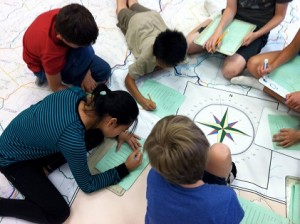
These publications join the good company of some classics also not named as place-based education as such for example Steven Levy’s Starting From Scratch and Ron Berger’s An Ethic of Excellence. We join the good company of many foundational texts written by the patriarchs of this practice: Greg Smith, David Sobel and David Greenwood (Greenwood formerly wrote under the name of Gruenewald). They paved the way for the educational community to consider this as a “new” practice as well as ways that the approach was linked to our collective rich critical/progressive history.
And there are other foundational texts for my work in the area of curriculum design. Most prominent, of course, are the books by Grant Wiggins and Jay McTighe that help us plan Understanding by Design.
This is admittedly a short view of the history of educational thought! Dewey, Friere, Whitehead and others were asking teachers to make meaningful connections for the student long ago by suggesting they turn attention to life outside of school. I explore this history in Chapter One of my book.
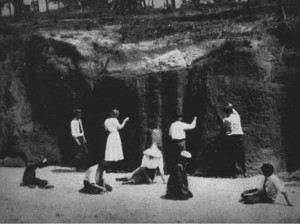
My book has a specific focus on curriculum design—what decisions and practices teachers have to adopt to orient their planned and enacted curriculum to the people and events that are happening outside the classroom…not only inside printed texts. It is lovely to be part of a movement that is percolating throughout the country as teachers turn to the places we live. Maybe this BOOK energy will bring local learning more prominently into the main current–so many good folks have paved the way–and are still at it! I am in good company indeed!!!
